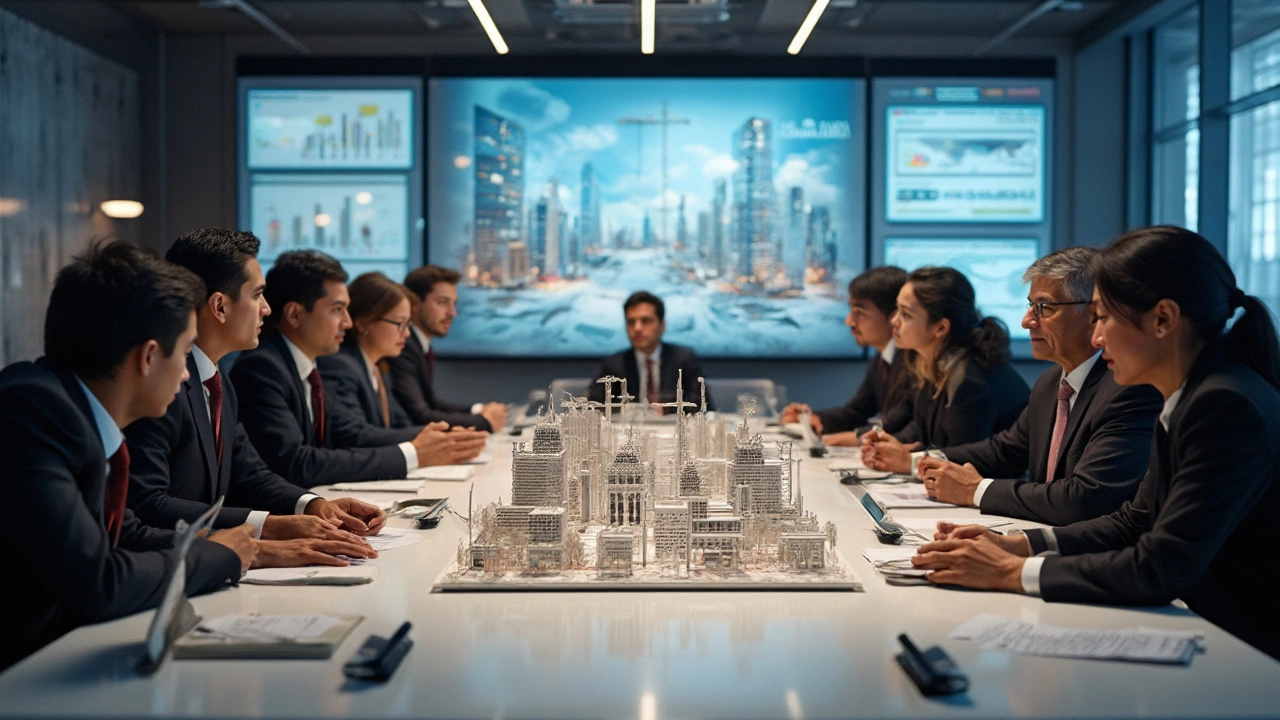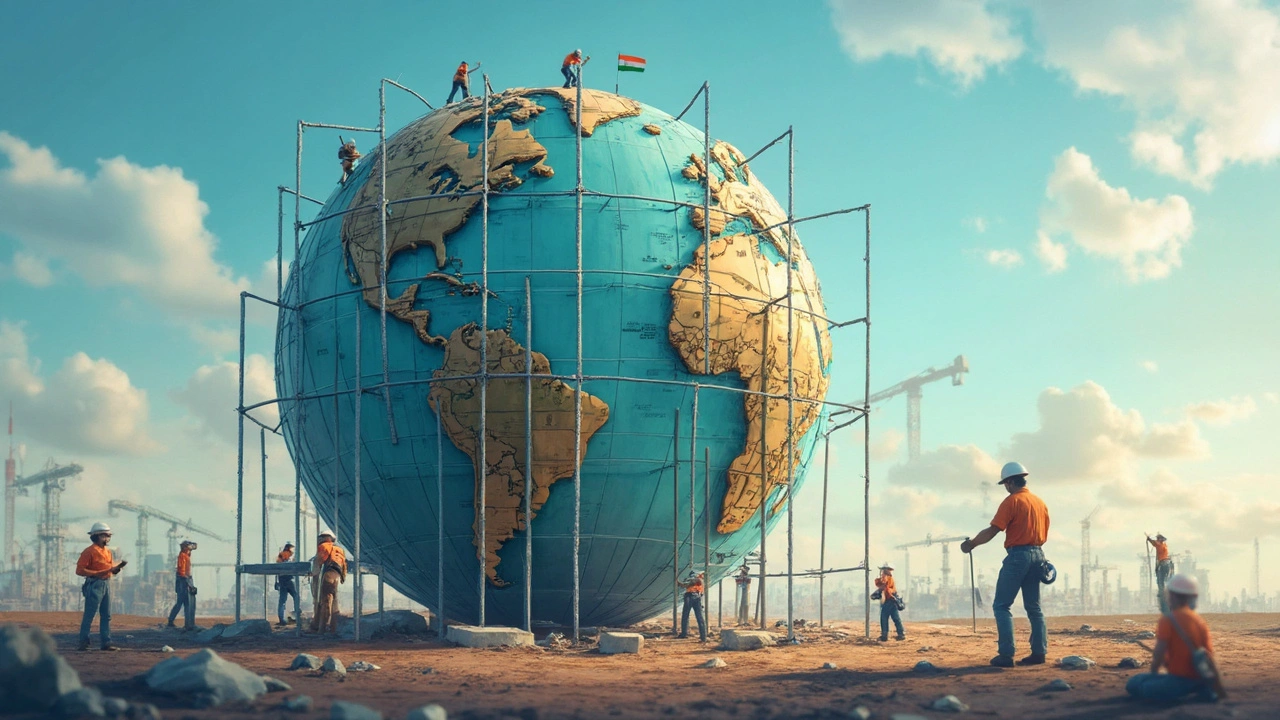When you think about building the world's biggest airports, breathtaking skyscrapers, or even bridges that seem to float in thin air, the same big names keep popping up. These construction giants don't just pour concrete—they build entire cities and set new standards for how we live and travel.
But what actually puts a construction company at the top of the global list? It’s not just about size. The leaders combine technical know-how, guts to tackle mind-bending projects, strong financials, and a reputation for getting stuff done safely and on time. It’s a crowded field, but a handful of companies have gained worldwide trust by pulling off jaw-dropping feats all across the globe.
If you’re hunting for a partner for your mega-project, or you’re just curious about how these companies rose to fame, knowing who’s leading the pack and why can help you make smarter decisions. Stick around to see who’s holding those top spots right now and what makes them worth watching in 2025.
- What Makes a Construction Company a Global Leader?
- Meet the Top 10 Construction Companies in 2025
- Game-Changing Projects from Industry Giants
- Tips for Picking the Right Construction Partner
- How the Construction Industry Is Evolving
What Makes a Construction Company a Global Leader?
Being at the top in the construction world isn’t just about finishing massive projects. These days, to get noticed worldwide, a construction company has to hit several marks. Let’s break it down.
First, financial muscle matters. Look at China State Construction Engineering Corporation (CSCEC) and Vinci—they both reported multi-billion dollar revenues in 2024, letting them tackle tough jobs in dozens of countries.
But money alone isn’t enough. Global leaders are known for delivering projects on time, every time. For instance, Bechtel finished one of the world’s largest natural gas terminals months ahead of schedule. That sort of track record grabs the attention of clients who can’t afford delays.
Technology and innovation also separate the top players. Balfour Beatty, for example, uses advanced BIM (Building Information Modeling) and AI to predict issues before ground is even broken. This isn’t science fiction—it helps them slash waste and control budgets.
Next up: experience across different sectors. The strongest firms build everything from railways in Egypt to stadiums in the US to solar farms in Australia. Their project lists look like world maps.
Safety isn’t just a buzzword. Companies like Skanska and Bouygues score high marks for safety records, thanks to strict training and real-time monitoring on jobsites. Clients don’t want lawsuits or work stoppages—so this is huge.
Last, reputation and repeat business are key. Major government contracts or partnerships with brands like Apple or Google aren’t handed out to just anyone. Building a solid reputation takes years of delivering results—and fixing mistakes fast when something goes sideways.
- Top construction companies combine financial strength, global reach, innovation, experience, safety, and a rock-solid reputation.
- They work on projects in all kinds of environments, from crowded city centers to remote deserts.
- They stay ahead by investing in new tech and constantly improving safety.
If you see a company checking all these boxes, you’re probably looking at one of the world’s real industry leaders.
Meet the Top 10 Construction Companies in 2025
These companies aren’t just big—they’re everywhere. From highways in the Middle East to mega-malls in China or high-speed rails in Europe, these players get the world’s toughest jobs. Here’s a full look at who’s at the top this year and why they matter.
- China State Construction Engineering Corporation (CSCEC): Still leading the pack. They’re the largest by revenue worldwide, with projects in over 100 countries. In 2024 alone, their revenue hit around $330 billion. CSCEC built the ultra-modern Beijing Daxing International Airport, one of the world’s largest.
- Vinci: France’s Vinci is a heavyweight, famous for finishing big jobs like the Stade de France and major European highways. In 2024, they pulled in about $65 billion. Vinci owns Eurovia, which means they build everything from bridges to urban train lines.
- ACS Group: Spain’s ACS has serious reach—they’ve led projects like the Crossrail in London and handle a huge chunk of Australia’s infrastructure. With revenues close to $40 billion in 2024, they’re known for speed and reliability.
- China Railway Group (CREC): These guys specialize in rail but have built tunnels and massive urban projects. CREC’s revenue last year was over $140 billion. Their work in Africa building new railways is record-breaking.
- Skanska: Based in Sweden but working worldwide, Skanska stands out for sustainable building. They were behind the World Trade Center Transportation Hub in New York. Their 2024 revenue: about $18 billion.
- Strabag: Austria’s Strabag keeps busy across Europe and the Middle East, focusing on highways, civil engineering, and airports. Last year, they crossed $20 billion in annual revenue.
- Bouygues Construction: From Paris to Hong Kong, Bouygues is everywhere. They’re known for energy-efficient towers and major hospitals. They had about $15 billion in revenue last year.
- Bechtel: The only American company regularly on this list, Bechtel is the muscle behind huge projects like the Riyadh metro in Saudi Arabia and U.S. nuclear facilities. They cleared over $17 billion in revenue in 2024.
- PowerChina: They’re not just about power plants. This Chinese company helps build cities and dams all over Asia and Africa. In 2024, their revenue was $85 billion.
- Hochtief: This German giant, mostly owned by Spain’s ACS, works on everything from airports to complex tunnels. Hochtief’s revenue sits around $27 billion, and they’re active in North America and Australia.
Here’s a quick comparison table so you don’t have to Google every number:
| Company | Country | 2024 Revenue (USD billions) | Known For |
|---|---|---|---|
| China State Construction Eng. Corp | China | 330 | Global megaprojects (airports, cities) |
| Vinci | France | 65 | European infrastructure, stadiums |
| China Railway Group (CREC) | China | 140 | Railways, tunnels, bridges worldwide |
| PowerChina | China | 85 | Energy, dams, urban development |
| ACS Group | Spain | 40 | Infrastructure (Europe, Australia) |
| Hochtief | Germany | 27 | Airports, complex tunnels |
| Strabag | Austria | 20 | Highways, airports, Europe/Mideast |
| Bechtel | USA | 17 | Mega infrastructure, energy, metro lines |
| Skanska | Sweden | 18 | Sustainable buildings, urban hubs |
| Bouygues Construction | France | 15 | Green towers, healthcare, transport |
If you’re sizing up the top construction companies for a big project, focus on scale, global reach, and the kind of jobs they handle. The right one will have the track record where it really counts.

Game-Changing Projects from Industry Giants
Some construction companies are famous not just for the size of their contracts, but for raising the bar on what’s possible. Let’s talk about some real game-changers that have made even seasoned pros do a double take.
For starters, China State Construction Engineering Corporation (CSCEC) wrapped up the Beijing Daxing International Airport in 2019, and folks still talk about its starfish-like shape and massive scale. This airport can handle 100 million passengers a year. That’s more people than most countries have residents.
Moving over to Europe, Vinci, the French giant, played a lead role in the expansion of the Grand Paris Express. This project isn’t just a new set of train tracks—it’s a whole new era for how millions get around Paris. When finished, it’ll double the metro’s length and connect suburbs that never had a straight shot to the city center.
In the Middle East, Saudi-based Saudi Binladin Group helped bring the expansion of the Holy Mosque in Mecca to life. It’s the biggest mosque in the world, and every single detail had to work for millions of visitors—not your average job site.
Meanwhile, America’s Bechtel pulled off the enormous Crossrail project in London—nicknamed the Elizabeth Line. We’re talking more than 100 kilometers of new railway and high-speed trains weaving under some of the world’s busiest streets.
Looking at these mega projects, you see more than big budgets. There’s tons of innovation, new green standards, and jobs for thousands. Here’s a quick look at some standouts:
| Company | Project Name | Location | Year Completed | Main Achievement |
|---|---|---|---|---|
| CSCEC | Beijing Daxing International Airport | China | 2019 | World’s largest terminal, unique design |
| Vinci | Grand Paris Express Expansion | France | Ongoing (to 2030) | Longest new metro network in Europe |
| Bechtel | Elizabeth Line (Crossrail) | UK | 2022 | Europe’s largest railway construction |
| Saudi Binladin Group | Holy Mosque Expansion | Saudi Arabia | 2019 | World’s largest mosque upgrade |
| Obayashi | Tokyo Skytree | Japan | 2012 | Tallest tower in the world at completion |
If you’re considering a partnership or looking to predict what’s next in the top construction companies scene, keep an eye on who’s not just building big—but building smart. The next big thing might just set a new benchmark for everyone else.
Tips for Picking the Right Construction Partner
Choosing a construction company is a big deal. You’re not just paying for bricks and labor—you’re trusting someone to deliver on time, stay on budget, and keep things safe. So, how do you spot the right company for your project? Here’s what actually matters, based on how the world’s top construction companies do business.
- Check experience where it counts. Look for a proven track record in projects like yours. For instance, Vinci and China State Construction Engineering have handled airports, railways, and stadiums—clear evidence they know what they're doing at any scale.
- Ask about safety and quality scores. Big players publish their incident rates and quality certifications. For example, Skanska boasted an incident rate of just 0.14 per 100 workers in 2024, far below the industry average.
- Financial stability matters. Don’t gloss over this. The global leaders usually show annual revenue growth and low debt-to-equity ratios. A shaky company can drag your whole project down.
- Look for tech adoption. The best firms use digital tools to cut costs and trim delays. In 2023, Bechtel cut project overruns by 25% after rolling out AI site monitoring. If a company relies only on "how it's always been done," move on.
- Ask about green building experience. Environmental rules are tighter than ever. If sustainability matters, pick a team with actual LEED or BREEAM certified projects under their belt.
- Talk to past clients. Reviews tell you how the company actually handles problems—not just the sales pitch.
To give you a quick comparison idea, here’s how some of the top companies stack up on key stats in 2024:
| Company | Annual Revenue (USD bn) | Average Project Size (USD m) | Key Markets | LEED Projects |
|---|---|---|---|---|
| Vinci | 62 | 800 | Europe, Africa | 410 |
| China State Construction | 305 | 1,500 | Asia, Africa, Middle East | 300 |
| Bechtel | 18 | 950 | USA, Middle East | 195 |
| Skanska | 18 | 600 | Nordics, USA | 220 |
When it comes time to sign on the dotted line, don’t just look at the price tag. A solid partner brings technical chops, smart processes, and a real-world record of getting it done safely. Get picky—it’s your project and your money at stake.

How the Construction Industry Is Evolving
The way we build stuff these days barely looks like it did even a decade ago. The construction world is going through some huge changes, and it's not just hype—real advances are speeding up jobs, making things safer, and even cutting costs.
One of the biggest shifts is the use of technology. Drones now check on work sites and spot problems before they turn into money pits. Advanced software lets teams see a virtual version of a building before a single brick is laid. And yes—robots and 3D printers are on actual job sites, making everything from bridges to apartment walls.
Green building is another big deal. Most of the top construction companies are taking climate change seriously. The big trend: buildings that use less energy, create less waste, and cost less to run. Companies are using solar panels, recycled materials, and smarter designs. In 2024, about 40% of all new commercial projects worldwide used some type of green building certification, which is double what it was five years ago.
Safety’s always been a concern, but now it’s all about using wearables like smart helmets and vests that track workers’ health stats and send alerts when things aren’t right. This move helped drop site accident rates by around 20% since 2021, according to stats from OSHA.
Here's a quick look at some real numbers driving these changes:
| Trend | Worldwide Adoption Rate (2024) |
|---|---|
| Drone Site Inspections | 67% |
| 3D Printing of Building Elements | 25% |
| Green Certification (Commercial) | 40% |
| Wearable Safety Tech | 33% |
What does this mean if you’re about to start a project? Ask about your contractor’s tech and safety upgrades and look for proven experience with green buildings. That’s how you know they’re not stuck in the past.

